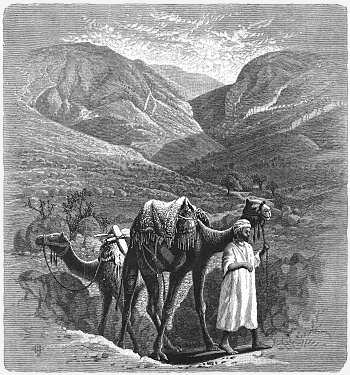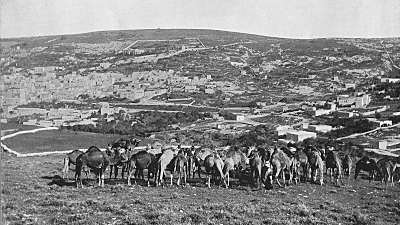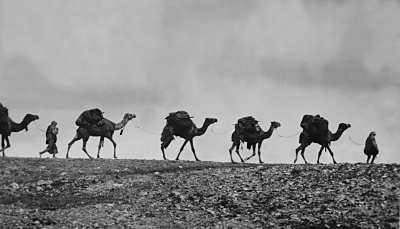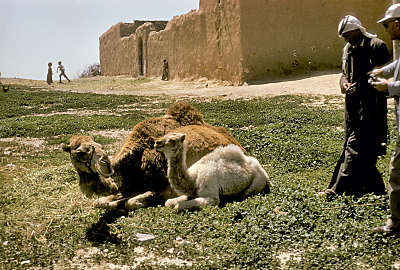
Camels in the Middle East
Train of Camels
It will be observed that camels form a conspicuous feature in many of the pictures. Indeed, go in any direction, one can hardly fail of seeing a large number of these strange creatures, with or without loads, jostling and crowding to make their way along, as though they formed a part of the inhabitants, and were pushing through the thoroughfares on business of their own. They need considerable room, but otherwise they make very little disturbance. Twenty or more horses, walking over the paved streets with their clattering hoofs, make an almost frightful din, while a string of a hundred camels will pass noiselessly, because their spongy feet fall on the stones like cushions. (Source: Picturesque Palestine, vol. 2, p. 174.)
’Ain El Weibeh, on the Border of Edom

Source: Picturesque Palestine, vol. 3, p. 210
The camel is fitly called “the ship of the desert.” It is admirably adapted for its use on the boundless ocean of sand from the Nile to the Euphrates. It has needed no repair since the days of Abraham, and could not be improved by any invention in navigation. It would be as impossible to cross the waterless desert without this wonderful animal as to cross the ocean without a ship. No horse or donkey would answer the purpose. The camel has the reputation of patient endurance and passive submission, which some, however, deny, or regard as mere stupidity . . . . It can travel five (some say nine, or even fifteen) days in scorching heat without water, and resorts to its inside tank or cistern, which, at the sacrifice of its own life, has saved the life of many a traveller . . . . It supplies its master with milk, fuel, sandals, and garments; and, having done its duty, it leaves its bleached skeleton in the arid waste as a landmark to future travellers (Source: Picturesque Palestine, vol. 2, p. 181).

Source: Earthly Footsteps of the Man of Galilee, p. 106
Camels Feeding at Nazareth
To the stranger the slow-paced camel with his soft-cushioned feet, his noiseless solemn tread, imperturbable patience imprinted upon his dun colored face, seems a picturesque and amiable animal, but to one who knows him well he is cross, discontented and often treacherous. H. M. Field in his "Review of Recent Events in Egypt'' says: "As my camel and I were to be on somewhat intimate terms, I approached to make her acquaintance, and even tendered her some little caressing. I attempted to stroke her gently; she instantly swung around her long neck and gave me a vicious snap which warned me not to presume on any familiarity." (Source: Earthly Footsteps of the Man of Galilee, p. 106.)
Camel with its Young on the Way to Beersheba
Professor Palmer thus describes . . . his first camel-ride: —"The camel is a much overrated beast, and is the very incarnation of peevish ill-temper. Docile he is, but apparently from no other reason than sheer stupidity. No sooner do you approach him than he sets up a hideous snarling groan; the driver pulls his head forcibly down to the ground, and you seize the opportunity of jumping on to his back. But before you can secure your seat you are suddenly pitched violently forward, then as violently backwards, for the creature gets up by jerks, and only half of him at a time. When once mounted the motion is not so unpleasant as it has been described, and a very few days makes you quite at home in your elevated seat.” (Source: Picturesque Palestine, vol. 4, pp. 8-9).
See Travel in Palestine, Travel in Desert, Travel by Sea, or Bedouin
At BiblePlaces, see Animals of the Bible or Southern Wildlife

